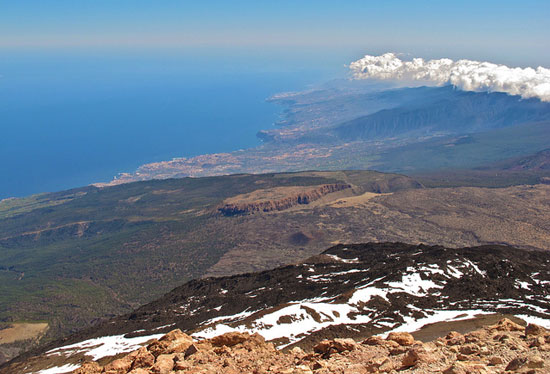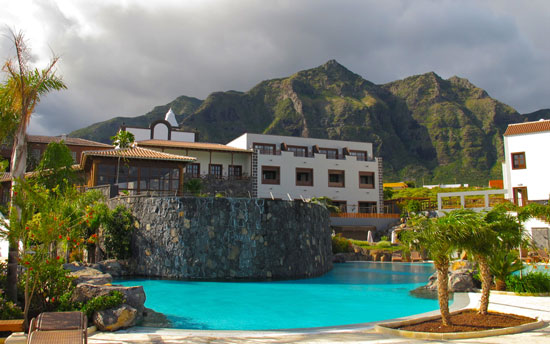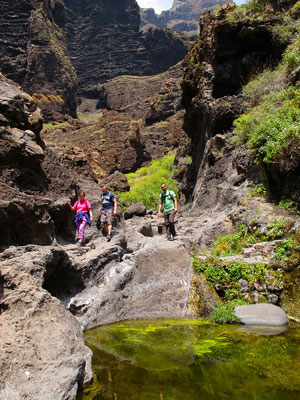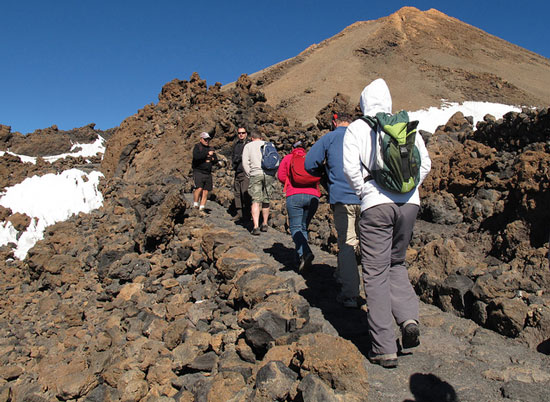

Tenerife, the largest of Spain’s Canary Islands off the coast of Morocco, is famous for its sunshine, bikini-clad “girls gone wild” and rowdy nightlife. But dig deeper—beyond the cabaret, karaoke and three-for-one-drink specials—visitors find this isle has a wild side that has nothing to do with slurping body shots from the naval of an 18-year-old.
To discover it for myself, I exchange my flip-flops for hiking boots and leave the hedonistic resorts of the south behind, buckling up for a 90-minute drive to the lusher, greener north. The highway hugs the coast, weaving between banana plantations on the plains before ascending through tunnels dynamited through the mountains. Along the way, towns painted in sherbet shades of mint green, sky blue, and terra cotta spill down hillsides and fan out over lava fields towards the Atlantic Ocean. Now and then, the journey reveals a fleeting glimpse of Mount Teide, a sleeping volcano that pierces the clouds at 12,200 feet.
For a better understanding of Tenerife’s fiery origins, I’ve strapped on a hard hat and miner’s headlamp to explore the isle’s underbelly with a two-hour tour of the Cueva del Viento (the “Cave of the Wind”), which is part of the longest volcanic tube system in Europe.

The cave system—which forms three levels, a phenomenon that has not been noted anywhere else on earth–was created 27,000 years ago by an eruption emanating from the Pico Viejo volcano. My friends and I are on the second level–a relatively dry, vast space, perhaps 10 feet high and as wide across. It’s even got built-in seating in the form of buttock-width ledges, which were formed when lava stagnated over a long period of time.
Fred Flintstone didn’t have such a raw deal, I reflect, until our guide asks us to switch off our headlamps so that we can experience what life is like for the cave’s other creepy crawly inhabitants—which, I only learn later, include giant black spiders and an eyeless cockroach. (Not that they’re the worst roommates I’ve ever had).
Of course, you needn’t shun the sun to find a bit of adventure. Sea kayaking is popular in Tenerife, and we spend an afternoon paddling past the stony cliffs of La Punta de Teno, sluicing through water so blue it looks like it was spiked with a tanker of Ty-D-Bol. Cinematographers are apparently equally impressed, as scenes from the sequel to “Clash of the Titans” were filmed here.
To truly appreciate the stunning landscape, however, you’ve got to hit the trails. The Barranco de Masca begins in the tiny village of Masca, precariously perched beneath rugged peaks in an area so remote that it’s only been accessible by road since the 1970s.
After fortifying ourselves at an al fresco bar with a barraquito (a combination of espresso, condensed milk and liquor, accompanied by a sliver of lemon), we begin the three-hour, five-mile-long descent—despite a sign at the trail head warning against landslides and advising that the beach far below is closed. Our guide, a laid-back Spanish bloke named Pepe, shrugs it off, explaining that the sign is outdated, and indeed, a steady parade of hikers carries on past us undeterred.

We’re soon swallowed up by steep valley walls, where cactus and palm trees cling for life to its nooks and crags. We see evidence of past lava flows, spilling over ledges like frozen fountains of rich, dark chocolate. We clamber down smooth white boulders alongside a crystalline stream and catch the reflection of the sky in placid, green pools. At the end, the path widens to reveal a crescent-shaped pebble beach framed by dramatic bluffs, where we catch a ferry to the port of Los Gigantes.
It’s the sort of place that holds you captive to its beauty, as Joe Johannes-Przywara, a shirtless, sunburned young German backpacker explains when we encounter him on the path. “I came here more than a month ago, with just enough food and water for two or three days,” he says, shifting the weight of a red knapsack. “Then I realized I like it here. I hike up to Masca to buy food, and I can drink water from a stream,” explains Johannes-Przywara, who sleeps in a cave. “So far it’s perfect,” he says, with the sort of enthusiasm I personally would reserve for a five-star hotel offering free massage, an open bar and butler service.
The Teide National Park is equally popular with cavemen (and women), I learn the next day, when I thumb my nose at Pele (the volcanic goddess, not the soccer player) by planning a hike to the top of Mt. Teide and across a crater.
Our guide, Juan-Carlos Melian Galvan, proffers a notebook featuring movie stills of Raquel Welch on the set of One Million Years B.C., parts of which were shot here in the park. “You can see how her fur bikini became shorter,” he notes as he compares images from the filming, revealing a keen eye for detail, particularly where two-piece pelts are concerned.
Ms. Welch’s impressive peaks aside, the pinnacle I’m most interested in is Mt. Teide, which last erupted in 1909–and is apparently overdue for another outburst. (Gulp). We’ve booked ahead to obtain a summit permit via a cable car that will take us to within about 650 feet of the very top.
Given the altitude, the steepness of the trail, and the shivering temperatures, it’s rough going to reach the summit—but my creaking efforts are put to shame by 82-year-old Anneliese Schueler, who is visiting with a German Alpine society. “Most of my companions are 15 or 20 years younger than me,” she says, “but one lady is 87 years old.”
Inspired, I huff and puff resolutely upwards and am ultimately rewarded by an unparalleled panorama of a Mars-like landscape where puffy white clouds gather on the blue horizon like billowing smoke.
I may be the only person ever to return from Tenerife without a tan—or a hangover—but it’s worth trading a little time by the beach or under a table for a view from the top of the world.

If You Go:
Getting there: Tenerife has two airports: Sur Reina Sofia in the south and Norte Los Rodeos in the north.
More information: Tenerife Tourism Corporation, www.webtenerife.co.uk.
Stay:
Vincii Seleccion Buenavista Golf & Spa, www.hotelvinccibuenavistagolf.com. Built into a hillside overlooking a coastal golf course, this 117-room five star hotel features multiple swimming pools and a spa.
La Quinta Roja, www.quintaroja.com. 16th century mansion located in a central square in the seaside town of Garachico.
Activities:
Kayaking and walking adventures: www.tenoactivo.com, www.elcardon.com
Boats from Masca Gorge beach to Los Gigantes: www.mascalosgigantes.com
Cueva del Viento: www.cuevadelviento.net.
Mt. Teide summit permit and cable car info: www.reservasparquesnacionales.es.
Author Bio: Amy Laughinghouse is based in London. Read more about her travel adventures at WWW.AMYLAUGHINGHOUSE.COM.
- How to Renew a US Passport Quickly and Affordably - April 19, 2024
- 6 Reasons to Visit Portland, Maine (+ Travel Tips) - April 18, 2024
- Cruising with Discovery Princess on the Mexican Riviera - March 30, 2024
